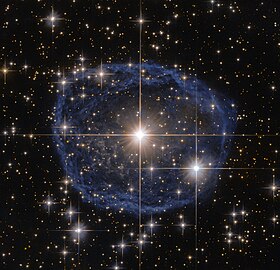| Revision as of 15:33, 11 March 2016 editArianewiki1 (talk | contribs)Extended confirmed users7,591 edits Requires citation, proof of statements, contradictions, misleading statements← Previous edit |
Revision as of 15:36, 11 March 2016 edit undoArianewiki1 (talk | contribs)Extended confirmed users7,591 edits bubble nebula is not an astronomical term, and relates to no cited source. Wolf-Rayet nebula is at least referenced.Next edit → |
| Line 52: |
Line 52: |
|
{{Starbox end}} |
|
{{Starbox end}} |
|
|
|
|
|
'''WR 31a''' is a ] in the southern constellation of ] that is surrounded by an expanding bubble nebula. It is more commonly referred to as '''Hen 3-519''', as it was known before being listed in the Catalogue of Wolf Rayet stars.{{Citation needed|Date=March 2016}} It is a suspected, dormant, or post-] (LBV).{{Citation needed|Date=March 2016}} |
|
'''WR 31a''' is a ] in the southern constellation of ] that is surrounded by an expanding nebula. It is more commonly referred to as '''Hen 3-519''', as it was known before being listed in the Catalogue of Wolf Rayet stars.{{Citation needed|Date=March 2016}} It is a suspected, dormant, or post-] (LBV).{{Citation needed|Date=March 2016}} |
|
|
|
|
|
==Properties== |
|
==Properties== |
| Line 60: |
Line 60: |
|
Hen 3-519 has been considered as a possible LBV almost since the term was first coined, although it has never shown the characteristic LBV variability. {{Proveit}} Its properties place it at the limit of temperature and luminosity for such stars, although comparable to the confirmed LBV AG Carinae.<ref name=davidson>{{cite journal|bibcode=1993ApJ...411..336D|title=He 3-519 - A peculiar post-LBV, pre-WN star?|journal=Astrophysical Journal|volume=411|pages=336|author1=Davidson|first1=Kris|last2=Humphreys|first2=Roberta M.|last3=Hajian|first3=Arsen|last4=Terzian|first4=Yervant|year=1993|doi=10.1086/172833}}</ref> |
|
Hen 3-519 has been considered as a possible LBV almost since the term was first coined, although it has never shown the characteristic LBV variability. {{Proveit}} Its properties place it at the limit of temperature and luminosity for such stars, although comparable to the confirmed LBV AG Carinae.<ref name=davidson>{{cite journal|bibcode=1993ApJ...411..336D|title=He 3-519 - A peculiar post-LBV, pre-WN star?|journal=Astrophysical Journal|volume=411|pages=336|author1=Davidson|first1=Kris|last2=Humphreys|first2=Roberta M.|last3=Hajian|first3=Arsen|last4=Terzian|first4=Yervant|year=1993|doi=10.1086/172833}}</ref> |
|
|
|
|
|
==Bubble Nebula== |
|
==Wolf-Rayet Nebula== |
|
The nebula around WR 31a was first catalogued by ] in 1953 as the ] '''Hf 39'''. {{Proveit}} Since 2013, the object has been considered not a planetary nebula but rather, an expanding shocked gas shell, formally classified as a ] or WR nebula.<ref name=frew>{{cite journal|doi=10.1093/mnras/sts393|title=A catalogue of integrated Hα fluxes for 1258 Galactic planetary nebulae|journal=Monthly Notices of the Royal Astronomical Society|volume=431|pages=2|year=2013|last1=Frew|first1=D. J.|last2=Bojicic|first2=I. S.|last3=Parker|first3=Q. A.|bibcode=2013MNRAS.431....2F}}</ref> Its observed expansion velocity is 365 km.s<sup>−1</sup>, estimated to be some 2.4 parsecs across.<ref name=toala/> |
|
The nebula around WR 31a was first catalogued by ] in 1953 as the ] '''Hf 39'''. {{Proveit}} Since 2013, the object has been considered not a planetary nebula but rather, an expanding shocked gas shell, formally classified as a ] or WR nebula.<ref name=frew>{{cite journal|doi=10.1093/mnras/sts393|title=A catalogue of integrated Hα fluxes for 1258 Galactic planetary nebulae|journal=Monthly Notices of the Royal Astronomical Society|volume=431|pages=2|year=2013|last1=Frew|first1=D. J.|last2=Bojicic|first2=I. S.|last3=Parker|first3=Q. A.|bibcode=2013MNRAS.431....2F}}</ref> Its observed expansion velocity is 365 km.s<sup>−1</sup>, estimated to be some 2.4 parsecs across.<ref name=toala/> |
|
|
|
|
The spectrum of Hen 3-519 contains both absorption and emission lines, intermediate between a hot supergiant and a Wolf-Rayet. On this basis it has been classified as Ofpe/WN9, a slash star. The same type of spectrum is also known as WN11, an extension of the traditional nitrogen sequence to cooler temperatures. It is a hydrogen-rich star, a young object rather than a highly evolved dying star.
Hen 3-519 has been considered as a possible LBV almost since the term was first coined, although it has never shown the characteristic LBV variability. Its properties place it at the limit of temperature and luminosity for such stars, although comparable to the confirmed LBV AG Carinae.
